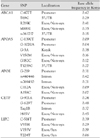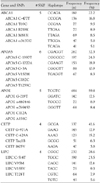1. Tai ES, Tan CE. Genes, diet and serum lipid concentrations: lessons from ethnically diverse populations and their relevance to coronary heart disease in Asia. Curr Opin Lipidol. 2004. 15:5–12.
2. Vincent S, Planells R, Defoort C, et al. Genetic polymorphisms and lipoprotein responses to diets. Proc Nutr Soc. 2002. 61:427–434.
3. Sviridov D, Nestel PJ. Genetic factors affecting HDL levels, structure, metabolism and function. Curr Opin Lipidol. 2007. 18:157–163.
4. Park KW, Choi JH, Kim HK, et al. The association of cholesteryl ester transfer protein polymorphism with high-density lipoprotein cholesterol and coronary artery disease in Koreans. Clin Genet. 2003. 63:31–38.
5. Shin MH, Kim HN, Cui LH, et al. The effect of apolipoprotein E polymorphism on lipid levels in Korean adults. J Korean Med Sci. 2005. 20:361–366.
6. Ko YK, Cho EY, Park HY, Jang Y, Kim S, Lee JE. Association of R219K polymorphism in the ABCA1 gene with plasma lipid levels and coronary artery disease in Koreans. Korean Circ J. 2003. 33:44–51.
7. Park KW, Chae IH, Choi JH, et al. The relationship of the C-514T polymorphism of the human hepatic lipase gene promoter with plasma HDL-C concentrations in Koreans. Korean Circ J. 2002. 32:25–30.
8. Park JS, Oh SJ, Kim KS, Ahn SH, Kim YK. Effect of diet and apoliprotein E (Apo E) polymorphism on the variation of serum lipid profile in Korean males. Korean Circ J. 1999. 29:266–275.
9. Jang Y, Kim JY, Kim OY, et al. The -1131T→C polymorphism in the apolipoprotein A5 gene is associated with postprandial hypertriacylglycerolemia; elevated small, dense LDL concentrations; and oxidative stress in nonobese Korean men. Am J Clin Nutr. 2004. 80:832–840.
10. Hunt SC, Hasstedt SJ, Kuida H, Stults BM, Hopkins PN, Williams RR. Genetic heritability and common environmental components of resting and stressed blood pressures, lipids, and body mass index in Utah pedigrees and twins. Am J Epidemiol. 1989. 129:625–638.
11. Perusse L, Rice T, Despres JP, et al. Familial resemblance of plasma lipids, lipoproteins and postheparin lipoprotein and hepatic lipases in the HERITAGE Family Study. Arterioscler Thromb Vasc Biol. 1997. 17:3263–3269.
12. Chen TJ, Ji CY, Pang ZC, Wang SJ, Hu YH, Qin Y. Heritability of serum lipids and lipoproteins and its related factors in twins aged 5 to 19 years of China. Zhonghua Yu Fang Yi Xue Za Zhi. 2004. 38:237–239.
13. Rohde K, Fuerst R. Haplotyping and estimation of haplotype frequencies for closely linked biallelic multilocus genetic phenotypes including nuclear family information. Hum Mutat. 2001. 17:289–295.
14. Abecasis GR, Cookson WO, Cardon LR. Pedigree tests of transmission disequilibrium. Eur J Hum Genet. 2000. 8:545–551.
15. Abecasis GR, Cardon LR, Cookson WO. A general test of association for quantitative traits in nuclear families. Am J Hum Genet. 2000. 66:279–292.
16. Fulker DW, Cherny SS, Sham PC, Hewitt JK. Combined linkage and association sib-pair analysis for quantitative traits. Am J Hum Genet. 1999. 64:259–267.
17. Feitosa ME, Rice T, Borecki IB, et al. Pleiotropic QTL on chromosome 12q23-q24 influences triglyceride and high-density lipoprotein cholesterol levels. Hum Biol. 2006. 78:317–327.
18. Hsiao CF, Chiu YF, Chiang FT, et al. Genome-wide linkage analysis of lipids in nondiabetic Chinese and Japanese from the SAPPHIRe family study. Am J Hypertens. 2006. 19:1270–1277.
19. Lin JP. Genome-wide scan on plasma triglyceride and high density lipoprotein cholesterol levels, accounting for the effects of correlated quantitative phenotypes. BMC Genet. 2003. 4:Suppl 1. S47.
20. Shah SH, Kraus WE, Crossman DC, et al. Serum lipids in the GENECARD study of coronary artery disease identify quantitative trait loci and phenotypic subsets on chromosomes 3q and 5q. Ann Hum Genet. 2006. 70:738–748.
21. Knoblauch H, Busjahn A, Munter S, et al. Heritability analysis of lipids and three gene loci in twins link the macrophage scavenger receptor to HDL cholesterol concentrations. Arterioscler Thromb Vasc Biol. 1997. 17:2054–2060.
22. Knoblauch H, Bauerfeind A, Toliat MR, et al. Haplotypes and SNPs in 13 lipid-relevant genes explain most of the genetic variance in high-density lipoprotein and low-density lipoprotein cholesterol. Hum Mol Genet. 2004. 13:993–1004.
23. Clark AG. The role of haplotypes in candidate gene studies. Genet Epidemiol. 2004. 27:321–333.
24. Bader JS. The relative power of SNPs and haplotype as genetic markers for association tests. Pharmacogenomics. 2001. 2:11–24.
25. Lee KW, Ayyobi AF, Frohlich JJ, Hill JS. APOA5 gene polymorphism modulates levels of triglyceride, HDL cholesterol and FERHDL but is not a risk factor for coronary artery disease. Atherosclerosis. 2004. 176:165–172.
26. Pennacchio LA, Olivier M, Hubacek JA, Krauss RM, Rubin EM, Cohen JC. Two independent apolipoprotein A5 haplotypes influence human plasma triglyceride levels. Hum Mol Genet. 2002. 11:3031–3038.
27. Talmud PJ, Martin S, Taskinen MR, et al. APOA5 gene variants, lipoprotein particle distribution, and progression of coronary heart disease. J Lipid Res. 2004. 45:750–756.
28. Singaraja RR, Brunham LR, Visscher H, Kastelein JJ, Hayden MR. Efflux and atherosclerosis: the clinical and biochemical impact of variations in the ABCA1 gene. Arterioscler Thromb Vasc Biol. 2003. 23:1322–1332.
29. Knoblauch H, Bauerfeind A, Krahenbuhl C, et al. Common haplotypes in five genes influence genetic variance of LDL and HDL cholesterol in the general population. Hum Mol Genet. 2002. 11:1477–1485.






 PDF
PDF ePub
ePub Citation
Citation Print
Print





 XML Download
XML Download